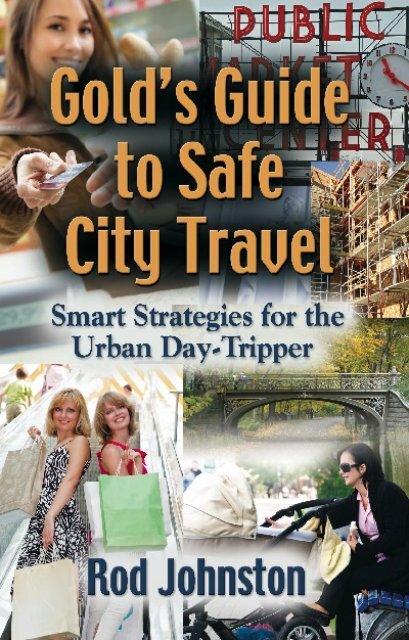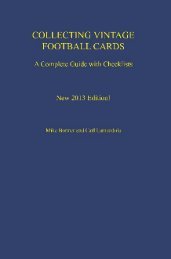free excerpt - The Book Locker
free excerpt - The Book Locker
free excerpt - The Book Locker
You also want an ePaper? Increase the reach of your titles
YUMPU automatically turns print PDFs into web optimized ePapers that Google loves.
Gold's Guide to Safe City Travel overflows with strategies and practical advice<br />
for city travel. An essential study for residents, commuters, shoppers, students,<br />
sightseers, event goers, and anyone likely to visit a city, this book includes<br />
chapters on pre-trip planning, traveling with children, driving, parking, using mass<br />
transit, and self-preservation. Twelve chapters, twelve real-life stories, an index,<br />
and over three hundred outlined tips help to ensure that urban day-trippers will<br />
"know before they go."<br />
Gold’s Guide to Safe City Travel<br />
Order the complete book from<br />
<strong>Book</strong>locker.com<br />
http://www.booklocker.com/p/books/6509.html?s=pdf<br />
or from your favorite neighborhood<br />
or online bookstore.<br />
Your Free <strong>excerpt</strong> appears below. Enjoy!
Gold’s Guide<br />
To<br />
SAFE CITY TRAVEL<br />
Smart Strategies for the Urban Day-Tripper<br />
Roderick D. Johnston
Copyright © 2012 Roderick D. Johnston<br />
ISBN 978-0-9719872-2-7<br />
All rights reserved. No part of this publication may be reproduced,<br />
stored in a retrieval system, or transmitted in any form or by any<br />
means, electronic, mechanical, recording or otherwise, without the<br />
prior written permission of the author.<br />
Published by Trans Mountain Publishing<br />
Printed in the United States of America on acid-<strong>free</strong> paper.<br />
Trans Mountain Group<br />
2012<br />
First Edition<br />
Trans Mountain Group<br />
P.O. Box 816<br />
Burnsville, NC 28714
Chapter 1: Travel Preparations<br />
Traveling to a city for the first time can usually fulfill a vision such as<br />
clarifying an image seen long ago on a postage stamp, or as imagined<br />
from reading a novel, or as remembered from a scene in a movie.<br />
Seeing a city for the first time allows us to understand more about that<br />
city than thousands of words could ever portray.<br />
Some of the finest restaurants are located in cities. Who can say<br />
enough about riding eighty floors up in an elevator to a building-top<br />
observatory to take in the view or sitting through nine innings of<br />
Major League baseball all while watching the city lights twinkle in the<br />
background? In a city, we can hear four movements of Handel, enjoy<br />
three floors of a museum, or rest while watching ducks float on a<br />
pond. In terms of people, cities exude the best and the worst of<br />
humanity. <strong>The</strong>re we can see who we have been, who we are today, and<br />
who we have to be tomorrow.<br />
Of course, the trick is knowing when and where to go in any city to<br />
enjoy its benefits. That may mean researching months in advance<br />
things like discount coupons, event tickets sales, days and hours of<br />
popular attractions, or reservations at a certain restaurant. In short,<br />
great city experiences require preparation. So then how do you<br />
prepare? First, study road maps and get familiar with that city. Learn<br />
how buildings are laid out block to block. Get a feel for where the<br />
5
Gold’s Guide to SAFE CITY TRAVEL<br />
bridges and tunnels are in relation to downtown. Second, where is<br />
your destination relative to all of this? Are you traveling downtown to<br />
the heart of the city or are you tripping to a suburban location? Third,<br />
how many ways can you drive to where you want to go? What is the<br />
most direct route? Being prepared entails knowing beforehand how-to<br />
comprehend transit schedules, identify landmarks such as parks and<br />
attractions, and understand the character of the area you will be<br />
visiting. If professional truckers, bus drivers, and cabbies have to<br />
prepare for city travel, shouldn’t you?<br />
Preparation requires facing your weaknesses. Afterall, not everyone<br />
can decipher a subway map, plan their route around one-way streets,<br />
or calculate the time it will take to reach a destination. For that matter,<br />
not everyone has a driver’s license. So, begin by asking yourself<br />
“How will I get into the city?” Will you be driving, bicycling, using<br />
mass transit, or walking into the city? Thinking about these issues will<br />
lead to thoughts about where to park, how to link with buses and<br />
trains, and how to avoid rush-hour traffic. Guarantee a successful day<br />
in the city by planning and scheduling your trip in advance. Take the<br />
time to get informed.<br />
Here are some tips to help you prepare for city travel:<br />
1. Study and understand an area before exploring it day or night.<br />
6
Smart Strategies for the Urban Day-Tripper<br />
2. Carry one or more street maps of the city that you are<br />
traveling to.<br />
3. For the cost-conscious, smaller restaurants tend to be more<br />
economical.<br />
4. If schedule matters, always allow extra time when traveling to<br />
or within a city.<br />
5. A state ID card can come in handy in lieu of using your<br />
driver’s license for identification.<br />
6. Find out where the most dangerous areas lie within a city.<br />
What are the names of these places?<br />
7. Ensure that your cell phone is always easy to access. Carry a<br />
backup and fully charged cell phone battery.<br />
8. To charge phones, cameras, laptops, and other rechargeable<br />
devices in one location, carry a lightweight power strip.<br />
9. For those constantly on the road, consider protecting your<br />
identity through use of a credit monitoring service.<br />
10. When possible, buy event tickets over the web. It is less<br />
cumbersome, you may get a choice of seats, and you are<br />
guaranteed admission.<br />
11. If you are running late, call and alert whoever is waiting for<br />
you that you are running behind schedule. Stay in touch until<br />
you arrive.<br />
12. Beyond friends, family, and close associates, discusses your<br />
travel plans with nobody. Keep this information off social<br />
networking sites.<br />
7
Gold’s Guide to SAFE CITY TRAVEL<br />
13. Check for deals. Some attractions offer discount pricing and<br />
cheaper multi-day admission when you purchase tickets over<br />
the Internet.<br />
14. Remember that a street side fast food restaurant will probably<br />
be cheaper than the same (or a competing) restaurant located<br />
in a museum or at an attraction.<br />
15. On a map, note where roads, mass transit lines, and stations<br />
merge. How do they link? Study this network to better<br />
understand how you can reach your destination.<br />
16. Store “In Case of Emergency” (ICE) numbers and 911 into<br />
your cell phone speed dial registry. (See (ICE) in chapter 12.)<br />
Show your children how to find and dial 911.<br />
17. Carry a recent group picture of everyone in your party in case<br />
someone gets lost. <strong>The</strong> odds of finding a lost person increase<br />
when people can reference a recent photo.<br />
18. If you must get online while traveling use caution at Internet<br />
cafes! Identity thieves love these places. You are better off at<br />
city buildings, upscale hotels, and school sites.<br />
19. Many city establishments honor a wide array of discounts.<br />
Take advantage of club, association, or credit card discounts<br />
available to you. Check your benefits before leaving home.<br />
20. Before traveling to a city, check with their Chamber of<br />
Commerce. Some Chambers offer special promotions and<br />
package deals that bundle attractions, restaurants, and transit<br />
tickets at very attractive rates.<br />
8
Smart Strategies for the Urban Day-Tripper<br />
21. Plan or GPS your route in and out of the city and stick to it.<br />
With a colored marker, highlight this route on your road map.<br />
Always let someone know where you are going and supply<br />
them with a duplicate color-coded map.<br />
22. Join a motorist or automobile club. <strong>The</strong>se organizations<br />
provide a wealth of travel resources and can be counted on<br />
should you need towing, road assistance, or on-the-spot<br />
advice over the phone. Consider them a 24-hour friend.<br />
23. Write down, and number in order, the places you plan to<br />
visit. Plan your route as efficiently as possible. One way to<br />
do this is to travel in a circuitous fashion. Walk minimal<br />
distances to see a maximum number of attractions. Think<br />
straight lines.<br />
24. If you will be meeting somebody that you do not know, get a<br />
picture and some personal information about this person<br />
beforehand. Take a copy of this information with you but<br />
leave the originals with somebody who will be waiting for<br />
you at home.<br />
25. Study the daily schedules of attractions that you plan on<br />
visiting. Museums, historic structures, and popular<br />
destinations usually operate at various times according to<br />
season and may vary their hours daily. On some days, they<br />
may not be open or they may close early.<br />
26. Before leaving home, make a copy of everything in your<br />
wallet or purse and store it in a safe place. Copy both sides of<br />
9
Gold’s Guide to SAFE CITY TRAVEL<br />
licenses, credit cards, phone number lists, medical cards and<br />
anything else worth having just in case you were to lose an<br />
original copy while traveling.<br />
27. Street maps do not always indicate obstacles impassable for<br />
pedestrians such as elevated or below-grade rail lines and<br />
highways, concrete barriers running down the center of<br />
streets, or utility right-of-ways. Check multiple maps before<br />
settling on a route and be prepared to alter your course if<br />
necessary.<br />
28. Before leaving home, make sure somebody knows whom you<br />
are with, where you will be going, and when you plan to<br />
return. Inform them of the type of vehicle you will drive as<br />
well as what you will be wearing. Leave this information in a<br />
note, on your answering service, as a phone message, or with<br />
someone at work.<br />
29. Inform credit and debit card sources of your travel plans to<br />
ensure your cards are not canceled when you use them. Some<br />
companies will <strong>free</strong>ze your card if they perceive fraudulent<br />
use. This happens when they notice your card being swiped<br />
in a location distant from where you usually use it. (I have<br />
had this happen to me twice in Haiti.)<br />
30. Do you plan to exercise while in the city? If so, always work<br />
out with someone else and stick to routes that are pedestriansafe.<br />
Walking scenic trails and bike paths that traverse<br />
secluded green areas keep you safe from vehicular traffic<br />
10
Smart Strategies for the Urban Day-Tripper<br />
however, the foliage and relative remoteness of these areas<br />
can leave you prey to whomever is lurking in the shadows. If<br />
attacked while working out, being physically exhausted can<br />
dull your ability to think clearly or react quickly. It is vital to<br />
reserve energy should you need to run, or think your way out<br />
of trouble, or have to physically battle a thug.<br />
31. Travel light. Only take what you will need. Leave<br />
checkbooks, calculators, redundant credit cards, and other<br />
extraneous forms of identification behind. You want to carry<br />
the essentials such as a driver’s license or state ID card,<br />
photo-identification, motor club card, health insurance cards,<br />
and medication. Since some shops and restaurants only<br />
accept certain credit cards, limit the number and type of<br />
credit cards that you carry. MasterCard and VISA seems<br />
enjoy universal acceptance. I usually carry one of them and<br />
an AMEX card. On your person and where you are staying,<br />
keep a separate photocopy of your credit and personal cards<br />
in case any are lost, or stolen.<br />
32. Use street-block lengths to judge walking distances. Most<br />
cities are laid out in rectangular grid-fashion so knowing the<br />
dimensions of the average block will enable you to quickly<br />
and accurately calculate distances and walking times,<br />
Measure the block distances on a map beforehand. To figure<br />
gross travel distance, multiply the number of blocks you plan<br />
to walk by their length. (Most maps have a scale.) Divide this<br />
11
Gold’s Guide to SAFE CITY TRAVEL<br />
number to determine miles or kilometers. When calculating<br />
on the run, avoid the pitfall of forgetting which city block<br />
axis is longer in length; the dimension between major<br />
avenues or the dimension between cross streets.<br />
33. Keep a backup-list of emergency phone numbers in your<br />
pocket should you happen to lose your wallet or purse.<br />
Typical numbers should include:<br />
• Phone card providers.<br />
• Credit card companies.<br />
• Your cellular phone service provider.<br />
• Nearest embassy or Consulate’s office.<br />
• <strong>The</strong> bank that handles your checking account.<br />
• Road service, AAA, and motorist association numbers.<br />
True Life Story Number 1 – Know Before You Go<br />
On a cold and snowy January day, a friend and I took the train across<br />
Canada from Montreal to Banff. On approaching Calgary, the<br />
conductor informed us that the train would be stopping for an hour. He<br />
suggested we use the time to explore the city. Restless after spending a<br />
sleepless night trying to fold ourselves comfortably into coach seating,<br />
we jumped at the idea. When the train stopped, we scurried up to street<br />
level and toured an icy Calgary. After forty-five minutes, we headed<br />
back to the train only to find bare tracks. <strong>The</strong> train had already left.<br />
Confused, after speaking with railroad personnel at the station, we<br />
12
Smart Strategies for the Urban Day-Tripper<br />
learned that our train had been gone for half an hour. Though nobody<br />
accused him, we learned that this particular conductor had a reputation<br />
for playing tricks on people, like leaving them stranded.<br />
Being that our luggage was still on the train, the railroad arranged to<br />
have it dropped off ahead at the next station in Banff. That was also<br />
our destination. Meanwhile at Calgary, we waited hours for the next<br />
train. We finally caught one and ended up reaching Banff after<br />
midnight. In below-zero cold, we retrieved our luggage from the<br />
frozen platform. Of course, everything by then was closed. Unable to<br />
locate a hotel room, we laid our sleeping bags down in a building<br />
under construction that the contractor was keeping warm with space<br />
heaters. Fortunate to have found a place protected from the cold<br />
Canadian night, we slept well before continuing our journey back to<br />
school in Idaho.<br />
Q@A<br />
Q: You mention planning the purchase of admission tickets. Can’t I<br />
buy tickets once we arrive at the zoo or at a museum?<br />
A: You sure can. Generally, there is no problem purchasing admission<br />
tickets to venues that operate daily. However, you may be out of luck<br />
if you try to purchase tickets for special events scheduled on the day<br />
you arrive. <strong>The</strong> same holds true for ball games, concerts, special tours,<br />
and the like. If you prefer good seats at an attractive price, plan and<br />
13
Gold’s Guide to SAFE CITY TRAVEL<br />
purchase your tickets beforehand. That way you will avoid long lines<br />
and possible disappointment. Call it peace of mind.<br />
Q: How far in advance should I purchase tickets?<br />
A: That depends on the affair. For intense rivalry-type sporting<br />
matches and popular concert entertainment, purchase your tickets as<br />
soon as you can. Keep an eye on what is coming up and when tickets<br />
will be available. Buy them months in advance. Some restaurants also<br />
require reservations. Call the restaurant you would like to visit and<br />
find out if they accept reservations. If they do, make them.<br />
Reservations are <strong>free</strong>. <strong>The</strong> key is planning. Also, consider the season.<br />
Holiday and weekend events require more advance planning.<br />
Q: We are going to fly in for a weekend of sightseeing. How should<br />
we plan?<br />
A: When flying, devote plenty of time to arriving back at the airport<br />
early. Plan plenty of time for the unexpected because the unexpected<br />
happens. For this reason, you may not have as much sightseeing time<br />
on the day of your arrival or departure. Unless somebody picks you up<br />
at the airport, you will need to rent a vehicle, hire a taxi, or use mass<br />
transit to reach your destination. <strong>The</strong> rules and strategies outlined in<br />
this book apply once you leave the airport.<br />
14
Smart Strategies for the Urban Day-Tripper<br />
Q: What about preparing with children? You didn’t mention them.<br />
A: Ah, you are right. We have not discussed much on that subject yet.<br />
If you move ahead to Chapter 5, you will find that it is devoted to<br />
traveling with children. In fact, that is the title of the chapter,<br />
Traveling with Children. I think you will find a ton of good<br />
information there. Meanwhile, it is on to Chapter 2 where we will<br />
explain how to make a good impression while strolling city streets.<br />
15
Chapter 2: Sidewalk Behavior<br />
It is easy to spot individuals that are comfortable in the city. <strong>The</strong>y<br />
exude a casual, business-as-usual presence. Some may dart and weave<br />
their way through the crowd, trying to make time, while others<br />
casually stroll along, unaffected by the enveloping hustle. Unwavering<br />
hard-core city people walk with their gaze fixed straight ahead, their<br />
eyes locked and motionless — like taillights on a midnight train. <strong>The</strong>y<br />
may glance sideways to check for oncoming traffic but because they<br />
know the terrain, they rarely pay attention to landmarks. In focusing to<br />
get from one place to another, people moving with purpose<br />
demonstrate that they have no time for nonsense. Silently, their actions<br />
tell others to leave them alone. Because confident people are not<br />
absorbed in their immediate travel, many have the mental capacity to<br />
deal with whatever circumstance may come their way. A reservoir of<br />
defense.<br />
However, image only goes so far. It may save somebody from being<br />
targeted for petty street crime but being able to manage precarious<br />
situations only comes with preparation, coaching, experience, the right<br />
tools, and most of all, a fearless demeanor to escape, stare down, beat<br />
back, or break whatever is threatening you. Day-trippers need to learn<br />
what street-savvy individuals already know. A key to avoiding trouble<br />
is perception. You want to be perceived as dangerous prey. You do not<br />
want to be looked at as a “given.” Goons and street thugs want an easy<br />
17
Gold’s Guide to SAFE CITY TRAVEL<br />
deal and they dread resistance. <strong>The</strong>y do not want to be tested. It’s too<br />
risky. Things may backfire. Unless they are flat out crazy, common<br />
street criminals – like most predators – prefer easy hits. So, to increase<br />
your odds of surviving in the city, carry yourself appropriately, melt<br />
into the crowd, and appear formidable.<br />
Here are some ways to accomplish this:<br />
34. Travel in groups.<br />
35. Be aware of your surroundings. What is going on around<br />
you?<br />
36. When moving through crowds, follow close behind and in<br />
the wake of others.<br />
37. Avoid walking while chatting on your cell phone. Find a safe<br />
place to sit and talk.<br />
38. Move with purpose. Be confident and always look like you<br />
know where you are going.<br />
39. To help deter hit and run robbers, walk close behind and<br />
block the side where a woman is carrying her pocketbook or<br />
bag.<br />
40. Trust your instincts. When approaching what appears to be<br />
trouble, if your impulse is to cross the street, do it and keep<br />
moving. Don’t look back. Just keep an eye on traffic.<br />
18
Smart Strategies for the Urban Day-Tripper<br />
41. In most jurisdictions, jaywalking is illegal. Do you see many<br />
people crossing illegally? Research the city you are traveling<br />
to or ask locals how the police treat jaywalking.<br />
42. When crossing alleys and driveways, give them the same<br />
respect that you would when crossing a busy street. Look for<br />
vehicles entering and leaving before walking in front of them.<br />
43. When traveling solo, stay within sight and shouting distance<br />
of other people. At times, traveling solo may warrant waiting<br />
for or catching up with normal-looking strangers, and then<br />
walking with them as if you are part of their group.<br />
44. Ignore comments passed your way. When passing suspicious<br />
characters, appear as though you are having a bad day.<br />
Crown your confidence with a scowl and clench a fist. Let<br />
others know that you are not worth it. Be somebody that<br />
someone else would rather pass up. Act as if you have<br />
nothing to lose.<br />
45. When walking, be aware of which streets carry one-way<br />
vehicular traffic. When crossing a one-way street, looking<br />
both ways and then pausing in contemplation that the street is<br />
indeed a “one-way” avenue is a dead giveaway that that you<br />
are a visitor. Or that you are lost. Or both. Look like you are<br />
used to one-way streets though you may not be.<br />
46. If you feel somebody is following you, walk against the flow<br />
of pedestrian traffic. In other words, be rude in order to test<br />
your intuition. Get noticed. This maneuver allows others to<br />
19
Gold’s Guide to SAFE CITY TRAVEL<br />
witness your predicament. If that person follows, seek help.<br />
Walking against the flow of pedestrian flow may also counter<br />
potential come-from-behind purse-snatchers.<br />
47. Before traveling through an area or along a walkway,<br />
consider the level of natural light present. Is the sidewalk or<br />
road illuminated well enough for you to see everything or are<br />
there areas hidden in shadows? Better lighting generally<br />
equates with better-behaved people. Criminals are drawn to<br />
less lighting. <strong>The</strong>y seek the shadows. Avoid these areas.<br />
48. When using a pay phone, guard what you say and do not let<br />
wandering eyes see you punch in credit card numbers, PIN<br />
numbers, and telephone numbers. When speaking into a<br />
public phone, cell phone, or a speaker box, remain discreet,<br />
speak quietly, and shield your lips. Look for strangers who<br />
may be listening in on your conversation and then adjust<br />
accordingly.<br />
49. Do not look up or marvel at skyscrapers. Yes, that is why you<br />
came and yes, they are awesome however gawking at them<br />
can announce one of two things: that you are new to town, or<br />
that you might be an unwary architect with deep pockets.<br />
People notice what you notice. Insignificant actions can<br />
broadcast more about you than what you want strangers to<br />
know.<br />
50. Avoid the rear of buildings, alleys, vacant lots, and heavy<br />
landscaping. Do not venture onto dead ends such as docks,<br />
20
Smart Strategies for the Urban Day-Tripper<br />
and stay off beaches, out of parks, and away from green<br />
space after dark. If you choose to travel down alleys and<br />
narrow streets, stay in the middle of the road. Avoid recessed<br />
doorways, garage doors, and places where thugs can hide. Be<br />
wary of anything that can shield your vision such as parked<br />
vehicles, dumpsters, trees, blind corners, and truck bays.<br />
51. Avoid animals and stray dogs. Rats, wild dogs, and alley cats<br />
found anywhere in a city can be aggressive and some are<br />
diseased. Where leash laws do not exist or are not enforced,<br />
pet dogs typically run <strong>free</strong>. When approached by a curious<br />
but strange dog, stay still and let it smell you. Running away<br />
or moving quickly may cause the dog to attack. Also, avoid<br />
approaching or touching police horses or animals accustomed<br />
to pulling carriages. Never walk behind a horse as such<br />
action can put you at risk of being kicked.<br />
52. When approached by a stranger, avoid eye contact but do not<br />
look down. Looking down can portray weakness. Keep your<br />
eyes fixed on where you are going. Appear bored with it all<br />
and walk with intent. If you hear someone mutter a<br />
compliment or mumble something, keep moving. If you catch<br />
someone’s eye and the person happens to float you a “feeler,”<br />
such as a smile or a welcoming gaze, respond with attitude.<br />
In most cases, this means acknowledging oncomers with a<br />
quick and affirmative head nod. Afterall, not everyone on<br />
city streets is out to get you. Most people are out to enjoy<br />
21
Gold’s Guide to SAFE CITY TRAVEL<br />
themselves. Others may be searching for allies. Moving on<br />
helps to remove you from potential danger while reinforcing<br />
that you are not interested in skullduggery.<br />
53. Pedestrians have the legal right of way at intersections.<br />
However, exercising this right is not worth gambling with<br />
your life. Not all drivers yield at intersections. Some<br />
disregard red lights and many have no respect for crosswalks.<br />
Do not trust eye contact with drivers as language to permit<br />
you to step into the street. Do not rely solely on lighted,<br />
musical, or mechanical signals to announce when it is safe to<br />
cross a busy intersection. <strong>The</strong> safest intersection is one where<br />
all traffic stops allowing pedestrians can cross to and from all<br />
corners at once. Unfortunately, such traffic control is<br />
becoming scarce. Use traffic signals as a guide only. Rely on<br />
your eyes and ears to confirm when it is safe to leave the<br />
curb. Speaking of curbs, stay clear of them. Step back. Give<br />
active traffic plenty of room.<br />
True Life Story Number 2 – Be Cautious Around<br />
Strange People<br />
One day, my college roommate and I went job hunting in Seattle.<br />
While waiting at a downtown intersection we were joined by other<br />
Seattleites, including an older man who was wearing a hat laced with<br />
toys and jingles hanging from strings. As a group, we crossed the<br />
22
Smart Strategies for the Urban Day-Tripper<br />
street and walked to the next intersection. While waiting for the light<br />
to change, the man with the hat turned on my six-foot eight-inch tall<br />
friend. He pulled out a knife and barked, “Leave me alone, I’m not<br />
kidding.” My friend was appalled. Though everybody had noticed the<br />
hat and toys, nobody had said anything to this person. We do not<br />
know why he chose to approach my friend but it did not matter. To<br />
some, size is an invitation. Just a bigger target. Anyway, everybody on<br />
the corner backed away from the knife-wielding man. <strong>The</strong>n, when the<br />
light changed, the disturbed man crossed the street alone, his boney<br />
skeleton a drift in over-sized cloths while the toys and jingles hanging<br />
from his hat danced in the breeze blowing off of Elliott Bay. <strong>The</strong><br />
lesson here is to be alert. If somebody or something seems odd,<br />
something odd may happen and it could come your way.<br />
Q&A<br />
Q: I am in the city to enjoy myself. Why should I act like someone I<br />
am not?<br />
A: <strong>The</strong> idea is to avoid making you a target. Blend in with the crowd.<br />
Appear as a local to everyone. Plan your trip well enough so that you<br />
know, at minimum, where you are and where you are going.<br />
Q: But I am on vacation. Isn’t this my time?<br />
23
Gold’s Guide to SAFE CITY TRAVEL<br />
A: Yes, it is. However, being on vacation is not reason-enough to<br />
travel in strange clothing, sling a 35mm camera over your shoulder,<br />
and break out large street maps at intersections while gawking up at<br />
skyscrapers. Try not to be conspicuous.<br />
Q: I am not there to stand out. I want to relax. I find it hard to walk<br />
with purpose when I am trying to take it easy. What’s wrong with<br />
that?<br />
A: Okay, let’s add the word complacent to conspicuous. By all means,<br />
relax and enjoy your travel experience. That is why you are there.<br />
However, stay focused and educate yourself as you move about the<br />
city. Learn as you go. Mentally compare street names and landmarks<br />
with what you remember from studying your maps. Do you see how<br />
planning and preparation help you better understand your<br />
surroundings while at the same time, allowing you the <strong>free</strong>dom to<br />
relax?<br />
Q: I’m confused. I still need to check my map. Do you expect me to<br />
memorize it?<br />
A: No. Just slip into a hotel, a department store, a restaurant -<br />
anywhere safe. Break out the map out and study it. People that work in<br />
such establishments are used to out-of-town visitors. While you are at<br />
24
Smart Strategies for the Urban Day-Tripper<br />
it, ask for some tips or advise. It is amazing what you will learn from<br />
the locals.<br />
Q: I see. <strong>The</strong>n…bags and packages just get in the way, don’t they?<br />
A: Unfortunately, they do. Too many handles, too many bags, and too<br />
much weight can all work against you should you have to react<br />
quickly to something. Besides, an abundance of carry-along items can<br />
make you vulnerable. <strong>The</strong>y may suggest that you could be a visitor<br />
and therefore, an easy target. Carrying too much of anything is<br />
cumbersome and it can be tiring. Ditch the bags and travel light or<br />
have your purchases mailed home.<br />
25
Gold's Guide to Safe City Travel overflows with strategies and practical advice<br />
for city travel. An essential study for residents, commuters, shoppers, students,<br />
sightseers, event goers, and anyone likely to visit a city, this book includes<br />
chapters on pre-trip planning, traveling with children, driving, parking, using mass<br />
transit, and self-preservation. Twelve chapters, twelve real-life stories, an index,<br />
and over three hundred outlined tips help to ensure that urban day-trippers will<br />
"know before they go."<br />
Gold’s Guide to Safe City Travel<br />
Order the complete book from<br />
<strong>Book</strong>locker.com<br />
http://www.booklocker.com/p/books/6509.html?s=pdf<br />
or from your favorite neighborhood<br />
or online bookstore.
















